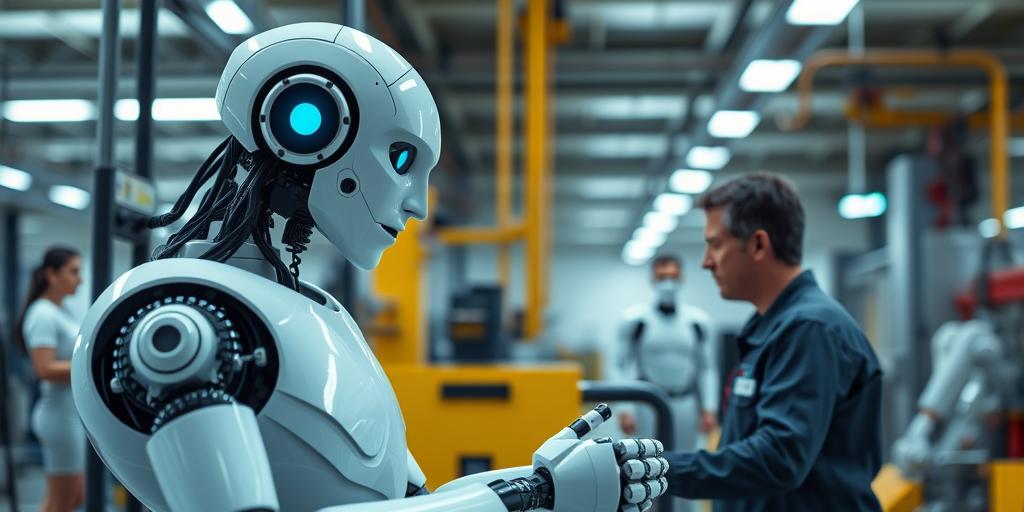Collaborative Robots (Cobots): Working Alongside Humans in 2025
As we look towards 2025, the integration of collaborative robots, or cobots, into the workplace is rapidly becoming a reality. Unlike traditional industrial robots that operate in isolation, cobots are designed to work alongside humans, enhancing productivity and safety. This article explores the current state of cobot technology, its projected growth, and the implications for various industries.
What are Collaborative Robots?
Collaborative robots are designed with advanced sensors and safety features that allow them to operate in close proximity to human workers. These robots are typically smaller, more flexible, and easier to program than their industrial counterparts. Key characteristics of cobots include:
- Safety Sensors: Cobots use sensors to detect when a human is nearby, allowing them to slow down or stop to prevent accidents.
- Ease of Programming: User-friendly interfaces make it simple to program cobots for specific tasks, reducing the need for specialized expertise.
- Flexibility: Cobots can be easily redeployed for different tasks, making them suitable for dynamic manufacturing environments.
- Lightweight Design: Their smaller size and weight make them easy to move and integrate into existing workspaces.
Market Growth and Projections
The cobot market has seen substantial growth in recent years, driven by increasing demand for automation and the need for more flexible manufacturing processes. According to a report by Mordor Intelligence, the collaborative robot market was valued at USD 1.23 billion in 2023 and is expected to reach USD 9.92 billion by 2029, growing at a CAGR of 41.21% during the forecast period.
Several factors contribute to this growth:
- Increasing Automation: Companies are seeking ways to automate repetitive and physically demanding tasks to improve efficiency and reduce costs.
- Aging Workforce: As the workforce ages, cobots can help fill labor shortages and support older workers by handling heavy lifting and other strenuous activities.
- Improved Safety Standards: Advancements in safety technology have made cobots a viable option for working alongside humans.
- Government Support: Many governments are offering incentives and funding for companies to adopt automation technologies, including cobots.
Applications Across Industries
Cobots are finding applications in a wide range of industries, including:
- Manufacturing: Cobots are used for assembly, machine tending, quality inspection, and material handling.
- Automotive: In the automotive industry, cobots assist with tasks such as welding, painting, and parts assembly.
- Electronics: Cobots are employed in the electronics industry for assembling small components, soldering, and testing.
- Food and Beverage: Cobots are used for packaging, palletizing, and quality control in food processing plants.
- Healthcare: In healthcare, cobots assist with tasks such as dispensing medication, transporting samples, and assisting with surgery.
Benefits of Cobots
The integration of cobots offers numerous benefits for businesses:
- Increased Productivity: Cobots can work continuously without fatigue, leading to higher output and faster production cycles.
- Improved Safety: By handling dangerous or repetitive tasks, cobots reduce the risk of workplace injuries.
- Enhanced Flexibility: Cobots can be easily reprogrammed for different tasks, allowing businesses to adapt quickly to changing market demands.
- Reduced Costs: While the initial investment in cobots can be significant, they can lead to long-term cost savings through increased efficiency and reduced labor costs.
- Better Quality: Cobots perform tasks with consistent precision, resulting in higher product quality and fewer defects.
Challenges and Considerations
Despite the many benefits, there are also challenges and considerations to keep in mind when implementing cobots:
- Initial Investment: The upfront cost of purchasing and integrating cobots can be a barrier for some businesses.
- Training and Education: Workers need to be trained on how to work safely and effectively with cobots.
- Integration Complexity: Integrating cobots into existing workflows may require significant changes to processes and layouts.
- Safety Standards: Ensuring that cobots meet all relevant safety standards is crucial to prevent accidents.
- Job Displacement: There are concerns that the widespread adoption of cobots could lead to job losses, although many argue that they will create new job opportunities in areas such as programming and maintenance.
The Future of Cobots
Looking ahead to 2025 and beyond, cobots are expected to become even more integrated into the workplace. Advancements in artificial intelligence, machine learning, and sensor technology will enable cobots to perform more complex tasks and interact more naturally with humans. Some potential future developments include:
- AI-Powered Cobots: Cobots will be equipped with AI algorithms that allow them to learn from experience and adapt to changing conditions.
- Advanced Sensors: New sensors will provide cobots with a more detailed understanding of their environment, enabling them to work safely and efficiently in dynamic settings.
- Cloud Connectivity: Cobots will be connected to the cloud, allowing them to share data and collaborate with other robots and systems.
- Human-Robot Collaboration: The focus will shift towards creating more seamless and intuitive interactions between humans and cobots.
Conclusion
Collaborative robots are poised to transform the way we work in 2025 and beyond. By combining the strengths of humans and robots, businesses can achieve higher levels of productivity, safety, and flexibility. While there are challenges to overcome, the potential benefits of cobots are undeniable, and their widespread adoption is likely to continue in the years to come. As technology advances and costs decrease, cobots will become an increasingly essential tool for businesses across a wide range of industries.
